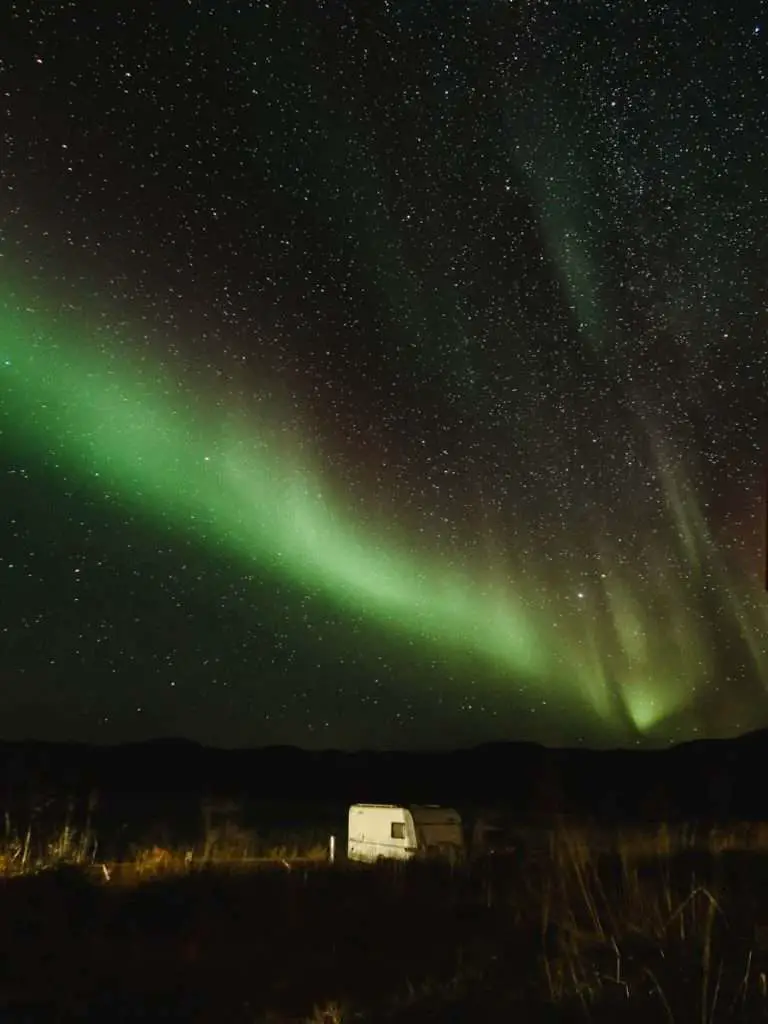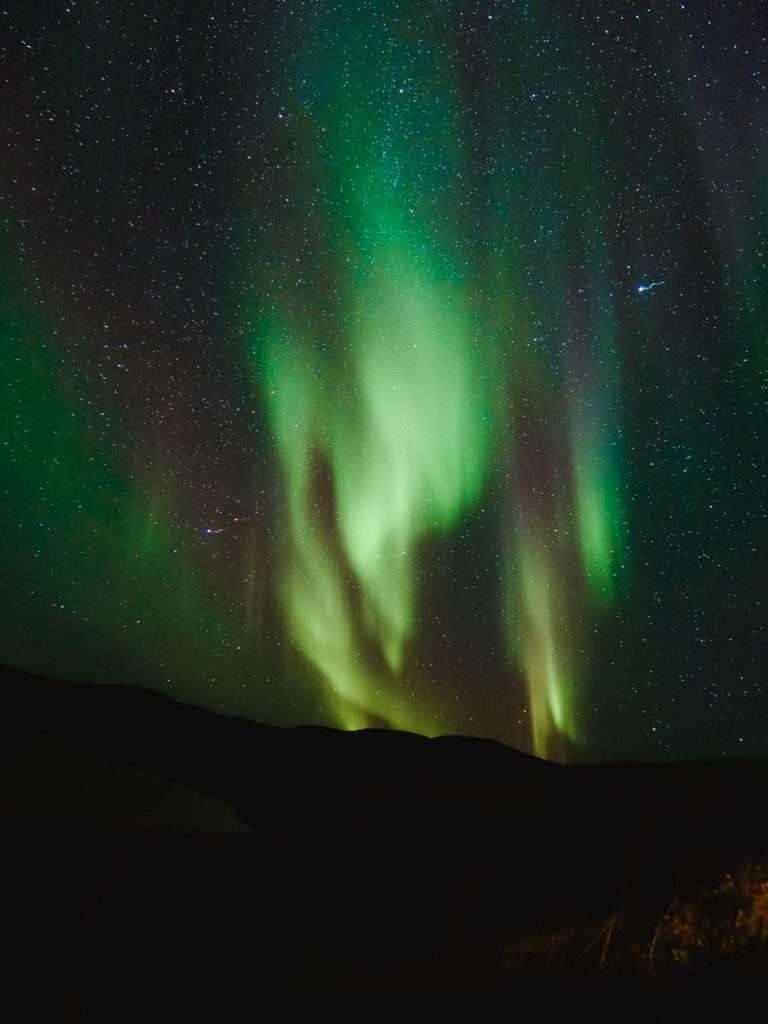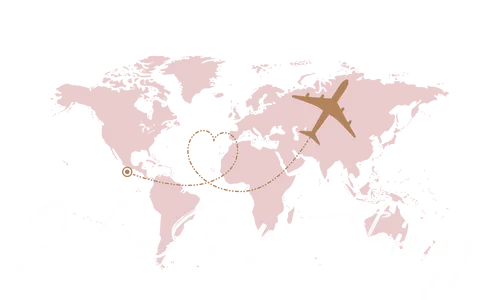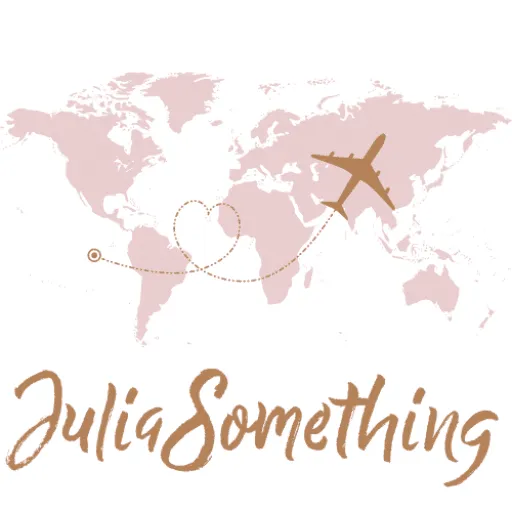The Northern Lights, or the Aurora Borealis, is a natural wonder that demands specific conditions for its grand appearance.
I saw the Northern Lights in Norway a couple of times during my month-long road trip in Norway in 2022.
And now, whenever Scandinavia crosses my mind, I can’t help but envision those mesmerizing lights gracefully dancing near the poles.
Now, if you haven’t witnessed this spectacle, get ready for a mind-blowing experience.
A lot of info you’ll find online about seeing the Northern Lights in Norway is a bit elusive and only explains the phenomena scientifically, but I will share my actual experience of seeing the Aurora with my own eyes.
Chasing the Northern Lights in Norway
The Northern Lights, or the Aurora Borealis, is a natural wonder that demands specific conditions for its grand appearance.
To catch a glimpse of these dancing lights, you’ll need a clear sky devoid of clouds and darkness, which is why this ethereal display isn’t visible in the summer months.
But let me tell you, the effort is absolutely worth it.
Witnessing the Northern Lights is a magical journey that many wanderers dream of, and Norway stands as one of the prime locations in the world to witness this extraordinary phenomenon.
Here are some key insights to keep in mind when planning your Northern Lights adventure in Norway.
So when’s the best time to see the Aurora?

The best month to see the Northern Lights
The prime time to witness the Northern Lights in Norway extends from September to April, peaking between November and February.
Surprisingly, this dazzling phenomenon occurs every day, though visibility is often hindered by poor conditions or light.
During my road trip to the North Cape in September, I experienced the perfect blend of chilly weather (perfect for a summer person like me) at 1 AM, with the Aurora gracefully dancing above me.
Despite scepticism from many who doubted the possibility of seeing the Northern Lights in September, I can affirm that it’s indeed achievable.
September does come with a drawback – frequent cloud cover, requiring a more extended stay in Norway to up your chances of catching the spectacle. However, the notion of a single “best” month is debatable.
While February is often touted as the optimal time due to clearer skies, the truth is the Northern Lights persist throughout the months from September to April.
It’s only a matter of statistics – February stands out for having the clearest skies, offering enhanced visibility.
Throughout these months, the long and dark nights provide the ideal conditions to marvel at the Northern Lights.
However, unpredictable weather requires careful consideration of the forecast to plan your experience accordingly.

Do the Northern Lights come every night?
While the Northern Lights grace the sky nearly every night, there’s no guarantee you’ll be treated to this celestial display during your visit, primarily due to the unpredictable presence of clouds.
Eager to ensure my encounter with the Aurora in the Arctic Circle, I embarked on a journey from the Lofoten Islands to Abisko, Sweden. Despite my efforts, luck was not on my side.
Nevertheless, there are strategies to enhance your chances of witnessing the Aurora Borealis.
Opting for a location with minimal light pollution, far from the glow of city lights, is crucial.
Abisko is often hailed on the internet as the ultimate Northern Lights destination, but this widespread acclaim might be more of a myth. I have my own story about Abisko, which I will share in a second.
Planning a trip solely based on this notion may not be the foolproof strategy it’s often portrayed to be.
Websites for Aurora forecast
I followed websites to try to increase my chances of seeing the Aurora:
Exact Aurora forecast for locations in Norway
Yr.no is a Norwegian weather website that is used by locals.
Use it to see all the details regarding the weather everywhere in Norway and around. If you search for a town or village, you will find it, and it will give you all the weather conditions for that spot, including an Aurora forecast.
Here is an example on the Tromso page, under “other conditions”:

Source: https://www.yr.no/en/other-conditions/1-305409/Norway/Troms/Troms%C3%B8/Troms%C3%B8
In that chart (Aurora chart on the right), you can check the hourly Aurora forecast.
In this example, you can see the Aurora activity between 18 to 06 am. As you move on the chart, you’ll see some hours have “No activity” while others have “low activity”, “medium activity”, or even “high activity” on some days.
However, you can also see the cloud forecast on the same chart.
So, for the forecast of “low activity” at 3 am, you should be able to see it. But that’s probably not going to happen since the forecast also shows 100% cloud cover, meaning that the entire sky will be covered by clouds.
I hope I explained it so that you can understand why no Aurora forecast can be made without forecasting the clouds for the area.
Aurora forecast activity level
Gi.alaska.edu is a really good website to track the Aurora activity levels all around the world, including in Europe.
The website accurately displays the activity level each day, on a KP index scale from 0 to 9.
This index is used to measure the geomagnetic activity.
While a higher KP index means a better chance to see the Aurora, it also means that the activity moves further from the poles, making it brighter and visible from mid-latitudes (makes the Aurora visible from further South, outside the Arctic Circle).
For instance, on nights with increased activity, one might be able to see the Northern Lights from Oslo or Stockholm, which is not as common as it is within the Arctic Circle.

Source: https://www.gi.alaska.edu/monitors/aurora-forecast (Select Europe)
Norway cloud forecast
Use Meteologix.com to see an accurate distribution of clouds over Scandinavia.
You can even zoom in on the map to see areas less covered by clouds.

Source: https://meteologix.com/no/model-charts/deu-hd/troms/total-cloud-coverage/20240120-1600z.html
VentuSky.com can also serve as a good tool to see the currency cloud situation in Norway.
You can search for a particular location to see the cloud forecast (from 0 to 100%). Note that 100% means that clouds cover the sky completely.
To get to this forecast, type in your location in the search bar, and then select the “clouds” forecast from the left-hand menu. At the bottom, you can select the day for the forecast and the exact hour.
For example, you see, on Jan 21, 2024, at 8 pm, Tromso will be free of clouds, as the cloud forecast is at 0%.

Source: https://www.ventusky.com/?p=69.28;20.02;6&l=clouds-total
Northern Lights in Abisko, Sweden
While I was in the Lofoten Islands, I saw the Aurora once, during my first night.
However, the rest of the week was cloudy. But I really wanted to see the Aurora again.
You see, once you see it, you want more of it, like some sort of addiction. But for me, it turned into a small obsession.
Travelling without much of a plan, as I usually do on my long road trips, I searched for places that had a cloud forecast of 0%. That mid-September morning, it seemed that Abisko, in Sweden, was going to be cloud-free, as it is usually advertised.
I drove all day to reach it, some 500 km that is, to reach the cheapest hostel (Abisko Hostel) I could find in Abisko, for about 80 EUR per night, for two people, with a shared bathroom.
The night came, and the sky seemed clear. We waited a bit more since the Aurora doesn’t start to show until 10 pm in September (that’s when it gets completely dark), and we went out hunting.
But to our surprise, there was a thin layer of clouds all around the area.
And then I drove towards Kiruna…
So, as I drove towards Kiruna, the road was pitch black, there were no cars on the road, no human soul in sight, and also… no Aurora.
I was driving on the national road, and every now and then, I would stop, turn off the lights and stuck my head out the window.
Every time, the conclusion was the same – no lights. After an hour of driving in one direction, I stopped in a parking lot on the side of the road and waited for a while.
I was with my boyfriend, and we felt enthusiastic for a while. We ate a snack and then stared at the sky again.
But there was no aurora in sight.
However, what made it really frustrating was that I could almost see it dancing on the other side of the clouds. It was just a tiny, diffuse greenish light, almost unperceivable to the human eye. It was probably around 1 am when we drove back to Abisko.
The last attempt was by the lake in Abisko, where we got outside the car and waited in the dark for a bit. Soon enough, however, we felt too cold to stay any longer, so we went back to the hostel.
The next morning, I drove back to Norway to continue my Norwegian road trip.
The conclusion here is to never chase the rumours. They say Abisko and Kiruna in Sweden are the top places to see the aurora, but that’s not true.
It all comes down to the forecast. So check those resources I already shared, and good luck. And dress accordingly.
Chasing the Lights: A Night at the North Cape Base Camp
Venturing to the North Cape, the northernmost point of continental Europe, marked a pivotal moment in my Norwegian road trip.
It was there, by the North Cape monument, that the harsh reality of the Arctic hit us – the wind was unforgiving, draining my camera batteries in minutes.
My only recourse for capturing this surreal landscape was my iPhone, unprepared for the challenge due to its full storage (this was pre-Cloud Storage enlightenment).
Note to future travellers: trust your iPhone in such extreme conditions and dress as if Everest awaits – winter jackets, mittens, hats, and scarves are a must.
Despite the biting wind, the views of the Arctic Ocean were breathtaking.
The distant silhouette of a remote Russian island added to the mystique of this inhospitable yet extraordinary place. However, the bitter cold soon became unbearable, and in under 15 minutes, my ears were in pain, and my extremities were numb.
However, at the last minute, I decided to stay another day at the campsite (the hut was heated anyway).
The weather forecast promised a rare 0% cloud cover for the evening – a stark contrast to the cloudy and rainy past week. Adding an extra 100 EUR to our accommodations seemed a small price for the potential reward of seeing the Aurora again.
As fate would have it, the weather forecast was accurate.
That night, September 25, 2022, at the North Cape Base Camp, I witnessed the most mesmerizing Northern Lights.

The spectacle was visible just above my cabin. I captured incredible pictures and videos, watching the lights dance across the Arctic sky for hours. The Milky Way was visible to the bare human eye.
It was like stepping into a new Universe.
The experience was truly priceless. In the end, it was worth enduring a bit of Arctic wind.

How to plan a trip to see the Northern Lights
If you plan a trip to see the Northern Lights in Norway, it’s important to consider the following:
- the time of year,
- location, and
- weather conditions.
I wrote a comprehensive Norway travel guide to help you plan your trip.
But if you’re just planning a few days in Norway, then these are your options.
Fly to Tromso
The largest international airport around is Tromso.
Then you’ll need to book your hotel, because winter is when all Aurora chasers go to Tromso so it’s pretty full. Here are some good hotels in and around Tromso if you’re planning to see the Aurora:
$$$ — BraMy Apartments The LUX View, Aera (cosy cabin 20 km from Tromso), Radisson Blu Hotel Tromsø
$$ — Tromsø Lodge & Camping, Comfort Hotel Xpress Tromsø, Bispegata 5 apartment hotel
$ — Ami Hotel, Studio close to downtown, Skagesund guest house with free parking
Many travel companies offer Northern Lights tours, which include accommodation, transportation, and activities.
But these are extremely overpriced offers, and I recommend that you plan your own trip. And I strongly advise that you rent a car in Tromso.
If you don’t have a car, experience driving during winter in cold climates, or simply don’t want to be bothered with all these logistics, then probably booking a Northern Lights tour is your best chance to see the magical spectacle of the Aurora.
If you’re short on time, then booking an Aurora tour is also something to consider.
Otherwise, you’ll need to research locations, weather conditions, and aurora activity to maximize your chances of seeing the Northern Lights.
Whatever option you choose, I hope you get to see these gorgeous lights, as they are truly one of the miracles on our planet. And they are one of those things most of us should have on our travel bucket list.

Northern Lights viewing: Norway vs Finland
When it comes to catching the Northern Lights, Norway and Finland stand out as top destinations, each offering a unique experience.
Personally, I find Norway to be my preferred spot, thanks to its dramatic fjords and coastal landscapes that create a breathtaking backdrop for the Aurora.
In Norway, the options are diverse – whether it’s the picturesque Lofoten Islands, the vibrant cities like Tromso or Bodo, or the untamed wilderness of the North Cape, you can choose from many beautiful locations.
On the flip side, Finland boasts vast wilderness forest areas, providing a different setting for Northern Lights viewing. Here, you can witness the night sky adorned with captivating dancing lights.
Some might opt for the extravagant experience of spending the night in an igloo or glass-roofed cabin. However, be prepared for the steep cost, and there’s no guarantee that you’ll be treated to the lights.
Despite the uncertainty, the experience is undeniably charming.
Many travellers also tend to compare Iceland and Norway for their natural attractions and the opportunity to see the aurora. Again, I’ll choose Norway every day.
In the end, the ideal destination depends on your preferences and travel style. Personally, I’m not keen on sitting and waiting for the lights to appear above me. However, who knows, you might strike luck (or be quite wealthy). The choice is yours to make, and the adventure awaits in these Northern wonders.







Tell me what you think!